Modeling and Enhanced Control of Hybrid Full Bridge–Half Bridge MMCs for HVDC Grid Studies
Abstract
:1. Introduction
2. MMC Description
3. MMC Control
- Arm energy control
- °
- Total converter energy control. This control regulates the total converter energy by setting the DC power if the MMC is in power control mode or the AC active power if the converter is in DC voltage mode.
- °
- Leg energy control. This control regulates the overall leg energy by means of the DC circulating current.
- °
- Common energy difference control. This control regulates the total energy difference between the upper and lower arms by using positive AC circulating currents.
- °
- Differential energy control. This control regulates the individual leg energy differences between the upper and lower arms by means of negative AC circulating currents.
- Capacitor balancing control
3.1. Enhanced Control
4. Hybrid MMC Modeling
4.1. SM Equivalent Circuit
4.2. Simplified Arm Thévenin Equivalent Model
5. Results
5.1. Control Validation
5.2. Verification of the Simplified Model
5.2.1. Normal Operation
5.2.2. DC Faults
5.2.3. AC Faults
5.2.4. Simulation Efficiency
5.2.5. Comparison with Other Models
6. Conclusions
Author Contributions
Funding
Conflicts of Interest
Abbreviations
| AC | Alternating current |
| DC | Direct current |
| HVDC | High voltage direct current |
| EMT | Electromagnetic transient |
| MMC | Modular multilevel converter |
| SM | Submodule |
| HB-SM | Half-bridge submodule |
| FB-SM | Full-bridge submodule |
| CBA | Capacitor balancing algorithm |
| AVM | Averaged value model |
| PI | Proportional-Integral |
| PIR | Proportional-Integral-Resonant |
| FPGA | Field-programmable gate array |
| IGBT | Insulated gate bipolar transistor |
References
- Tang, G.; He, Z.; Pang, H.; Huang, X.; Zhang, X.P. Basic topology and key devices of the five-terminal DC grid. CSEE J. Power Energy Syst. 2015, 1, 22–35. [Google Scholar] [CrossRef]
- Rao, H. Architecture of Nan’ao multi-terminal VSC-HVDC system and its multi-functional control. CSEE J. Power Energy Syst. 2015, 1, 9–18. [Google Scholar] [CrossRef]
- Michi, L.; Donnini, G.; Giordano, C.; Scavo, F.; Luciano, E.; Aluisio, B.; Vergine, C.; Pompili, M.; Lauria, S.; Calcara, L.; et al. New HVDC technology in Pan-European power system planning. In Proceedings of the 2019 AEIT HVDC International Conference (AEIT HVDC), Florence, Italy, 9–10 May 2019; pp. 1–6. [Google Scholar] [CrossRef]
- Gomis-Bellmunt, O.; Sau-Bassols, J.; Prieto-Araujo, E.; Cheah-Mane, M. Flexible converters for meshed HVDC grids: From Flexible AC transmission systems (FACTS) to Flexible DC grids. IEEE Trans. Power Deliv. 2019. [Google Scholar] [CrossRef]
- Saad, H.; Dennetiere, S.; Mahseredjian, J. On modelling of MMC in EMT-type program. In Proceedings of the 2016 IEEE 17th Workshop on Control and Modeling for Power Electronics (COMPEL), Trondheim, Norway, 27–30 June 2016; pp. 1–7. [Google Scholar] [CrossRef]
- Saad, H.; Dennetière, S.; Mahseredjian, J.; Delarue, P.; Guillaud, X.; Peralta, J.; Nguefeu, S. Modular Multilevel Converter Models for Electromagnetic Transients. IEEE Trans. Power Deliv. 2014, 29, 1481–1489. [Google Scholar] [CrossRef]
- Khan, S.; Tedeschi, E. Modeling of MMC for Fast and Accurate Simulation of Electromagnetic Transients: A Review. Energies 2017, 10, 1161. [Google Scholar] [CrossRef] [Green Version]
- Pang, H.; Zhang, F.; Bao, H.; Joos, G.; Wang, W.; Li, W.; Gregoire, L.A.; Zhai, X. Simulation of modular multilevel converter and DC grids on FPGA with sub-microsecond time-step. In Proceedings of the 2017 IEEE Energy Conversion Congress and Exposition (ECCE), Cincinnati, OH, USA, 1–5 October 2017; pp. 2673–2678. [Google Scholar] [CrossRef]
- Shen, Z.; Dinavahi, V. Real-Time Device-Level Transient Electrothermal Model for Modular Multilevel Converter on FPGA. IEEE Trans. Power Electron. 2016, 31, 6155–6168. [Google Scholar] [CrossRef]
- Tormo, D.; Idkhajine, L.; Monmasson, E.; Vidal-Albalate, R.; Blasco-Gimenez, R. Embedded real-time simulators for electromechanical and power electronic systems using system-on-chip devices. Math. Comput. Simul. 2019, 158, 326–343. [Google Scholar] [CrossRef]
- Gnanarathna, U.; Gole, A.; Jayasinghe, R. Efficient Modeling of Modular Multilevel HVDC Converters (MMC) on Electromagnetic Transient Simulation Programs. IEEE Trans. Power Deliv. 2011, 26, 316–324. [Google Scholar] [CrossRef] [Green Version]
- El-Khatib, W.Z.; Holbøll, J.; Rasmussen, T.W. High frequent modelling of a modular multilevel converter using passive components. In Proceedings of the International Conference on Power Systems Transients, Vancouver, BC, Canada, 18–20 June 2013. [Google Scholar]
- Xu, J.; Zhao, C.; Liu, W.; Guo, C. Accelerated Model of Modular Multilevel Converters in PSCAD/EMTDC. IEEE Trans. Power Deliv. 2013, 28, 129–136. [Google Scholar] [CrossRef]
- Zhang, F.; Yang, X.; Wang, K.; Xu, G.; Huang, L.; Chen, W. A discrete time-domain model for fast simulation of MMC circuits. In Proceedings of the 2016 IEEE 8th International Power Electronics and Motion Control Conference (IPEMC-ECCE Asia), Hefei, China, 22–26 May 2016; pp. 2366–2370. [Google Scholar] [CrossRef]
- Vidal-Albalate, R.; Belenguer, E.; Beltran, H.; Blasco-Gimenez, R. Efficient model for modular multi-level converter simulation. Math. Comput. Simul. 2016, 130, 167–180. [Google Scholar] [CrossRef] [Green Version]
- Ajaei, F.B.; Iravani, R. Enhanced Equivalent Model of the Modular Multilevel Converter. IEEE Trans. Power Deliv. 2015, 30, 666–673. [Google Scholar] [CrossRef]
- Xu, J.; Ding, H.; Fan, S.; Gole, A.M.; Zhao, C. Enhanced high-speed electromagnetic transient simulation of MMC-MTdc grid. Int. J. Electr. Power Energy Syst. 2016, 83, 7–14. [Google Scholar] [CrossRef]
- Ahmed, N.; Angquist, L.; Mahmood, S.; Antonopoulos, A.; Harnefors, L.; Norrga, S.; Nee, H.P. Efficient Modeling of an MMC-Based Multiterminal DC System Employing Hybrid HVDC Breakers. IEEE Trans. Power Deliv. 2015, 30, 1792–1801. [Google Scholar] [CrossRef]
- Ahmed, N.; Angquist, L.; Norrga, S.; Nee, H.P. Validation of the continuous model of the modular multilevel converter with blocking/deblocking capability. In Proceedings of the 10th IET International Conference on AC and DC Power Transmission (ACDC 2012), Birmingham, UK, 4–5 December 2012. [Google Scholar] [CrossRef]
- Ahmed, N.; Angquist, L.; Norrga, S.; Antonopoulos, A.; Harnefors, L.; Nee, H.P. A Computationally Efficient Continuous Model for the Modular Multilevel Converter. IEEE J. Emerg. Sel. Topics Power Electron. 2014, 2, 1139–1148. [Google Scholar] [CrossRef]
- Zhang, H.; Jovcic, D.; Lin, W.; Far, A.J. Average value MMC model with accurate blocked state and cell charging/discharging dynamics. In Proceedings of the 2016 4th International Symposium on Environmental Friendly Energies and Applications (EFEA), Belgrade, Serbia, 14–16 September 2016; pp. 1–6. [Google Scholar] [CrossRef]
- Yang, H.; Dong, Y.; Li, W.; He, X. Average-Value Model of Modular Multilevel Converters Considering Capacitor Voltage Ripple. IEEE Trans. Power Deliv. 2017, 32, 723–732. [Google Scholar] [CrossRef]
- Najmi, V.; Nazir, M.N.; Burgos, R. A new modeling approach for Modular Multilevel Converter (MMC) in D-Q frame. In Proceedings of the 2015 IEEE Applied Power Electronics Conference and Exposition (APEC), Charlotte, NC, USA, 15–19 March 2015; pp. 2710–2717. [Google Scholar] [CrossRef]
- Sinha, Y.; Nampally, A. Averaged model of modular multilevel converter in rotating DQ frame. In Proceedings of the 2016 IEEE International Conference on Renewable Energy Research and Applications (ICRERA), Birmingham, UK, 20–23 November 2016; pp. 319–324. [Google Scholar] [CrossRef]
- Jamshidi Far, A.; Jovcic, D. Small-Signal Dynamic DQ Model of Modular Multilevel Converter for System Studies. IEEE Trans. Power Deliv. 2016, 31, 191–199. [Google Scholar] [CrossRef] [Green Version]
- Wang, Q.; Ye, H.; Zhang, G. Improved dynamic phasor-based modeling and simulation of modular multilevel converter. In Proceedings of the 2017 IEEE Conference on Energy Internet and Energy System Integration (EI2), Beijing, China, 26–28 November 2017; pp. 1–6. [Google Scholar] [CrossRef]
- Peralta, J.; Saad, H.; Dennetiere, S.; Mahseredjian, J.; Nguefeu, S. Detailed and Averaged Models for a 401-Level MMC-HVDC System. IEEE Trans. Power Deliv. 2012, 27, 1501–1508. [Google Scholar] [CrossRef]
- Longze, K.; Lin, Z.; Fangyuan, L. Electromechanical modelling of modular multilevel converter based HVDC system and its application. In Proceedings of the 2017 IEEE Conference on Energy Internet and Energy System Integration (EI2), Beijing, China, 26–28 November 2017; pp. 1–6. [Google Scholar] [CrossRef]
- Coronado, L.; Longas, C.; Rivas, R.; Sanz, S.; Bola, J.; Junco, P.; Perez, G. INELFE: Main description and operational experience over three years in service. In Proceedings of the 2019 AEIT HVDC International Conference (AEIT HVDC), Florence, Italy, 9–10 May 2019; pp. 1–6. [Google Scholar]
- Marquardt, R. Modular Multilevel Converter: An universal concept for HVDC-Networks and extended DC-Bus-applications. In Proceedings of the International Power Electronics Conference (IPEC), Sapporo, Japan, 21–24 June 2010; pp. 502–507. [Google Scholar] [CrossRef]
- Xu, J.; Zhao, P.; Zhao, C. Reliability Analysis and Redundancy Configuration of MMC With Hybrid Submodule Topologies. IEEE Trans. Power Electron. 2016, 31, 2720–2729. [Google Scholar] [CrossRef]
- Zeng, R.; Xu, L.; Yao, L. An improved modular multilevel converter with DC fault blocking capability. In Proceedings of the 2014 IEEE PES General Meeting|Conference & Exposition, National Harbor, MD, USA, 27–31 July 2014; pp. 1–5. [Google Scholar] [CrossRef]
- Qin, J.; Saeedifard, M.; Rockhill, A.; Zhou, R. Hybrid Design of Modular Multilevel Converters for HVDC Systems Based on Various Submodule Circuits. IEEE Trans. Power Deliv. 2015, 30, 385–394. [Google Scholar] [CrossRef]
- Li, R.; Adam, G.P.; Holliday, D.; Fletcher, J.E.; Williams, B.W. Hybrid Cascaded Modular Multilevel Converter with DC Fault Ride-Through Capability for the HVDC Transmission System. IEEE Trans. Power Deliv. 2015, 30, 1853–1862. [Google Scholar] [CrossRef] [Green Version]
- Li, R.; Xu, L.; Guo, D. Accelerated switching function model of hybrid MMCs for HVDC system simulation. IET Power Electron. 2017, 10, 2199–2207. [Google Scholar] [CrossRef] [Green Version]
- Lin, W.; Jovcic, D.; Nguefeu, S.; Saad, H. Full-Bridge MMC Converter Optimal Design to HVDC Operational Requirements. IEEE Trans. Power Deliv. 2016, 31, 1342–1350. [Google Scholar] [CrossRef] [Green Version]
- Cui, S.; Sul, S.K. A Comprehensive DC Short-Circuit Fault Ride Through Strategy of Hybrid Modular Multilevel Converters (MMCs) for Overhead Line Transmission. IEEE Trans. Power Electron. 2016, 31, 7780–7796. [Google Scholar] [CrossRef]
- PSCAD. Available online: https://hvdc.ca/knowledge-base/topic:45/v: (accessed on 25 October 2019).
- Tu, Q.; Xu, Z.; Xu, L. Reduced Switching-Frequency Modulation and Circulating Current Suppression for Modular Multilevel Converters. IEEE Trans. Power Deliv. 2011, 26, 2009–2017. [Google Scholar] [CrossRef]

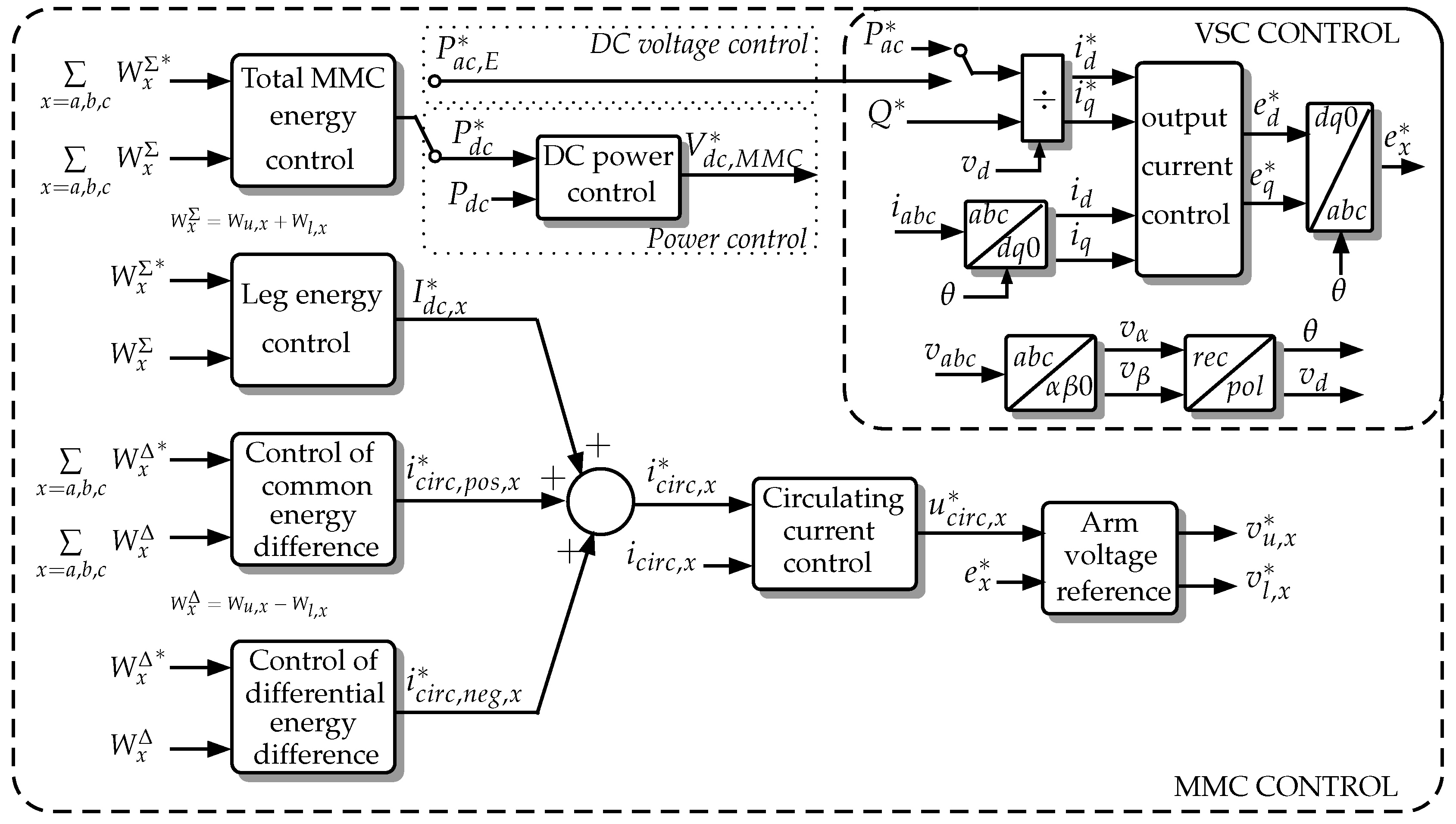
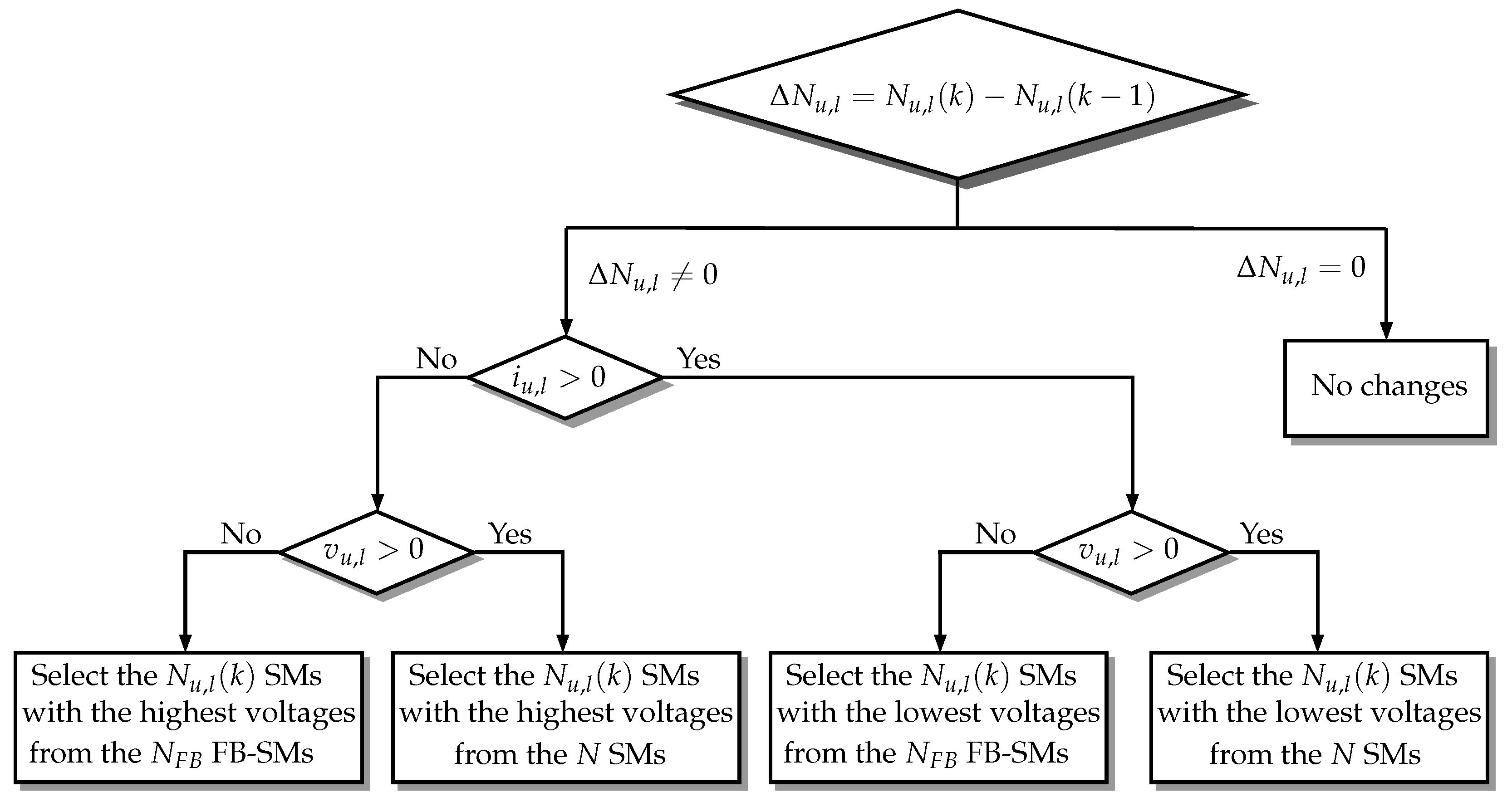


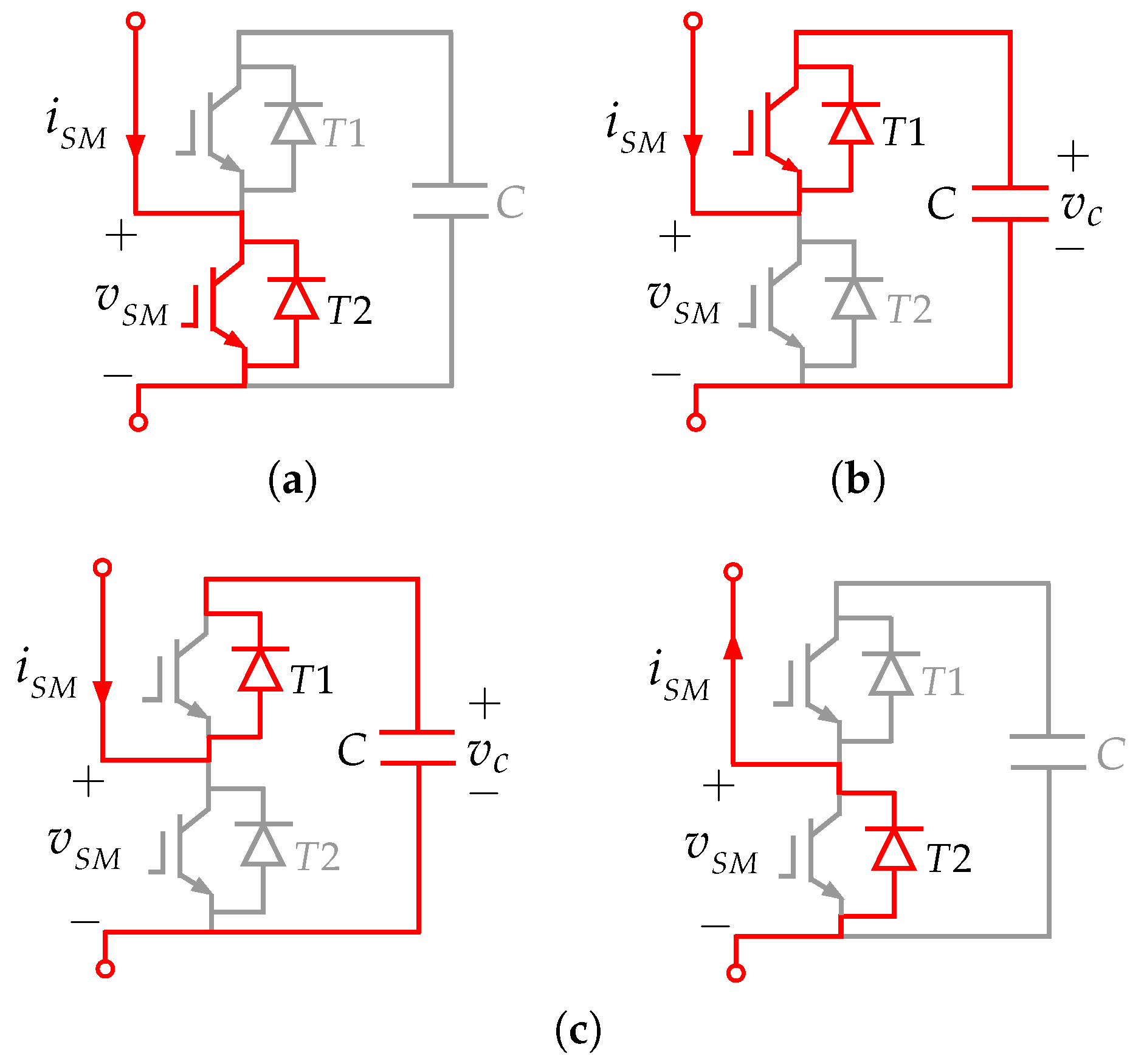



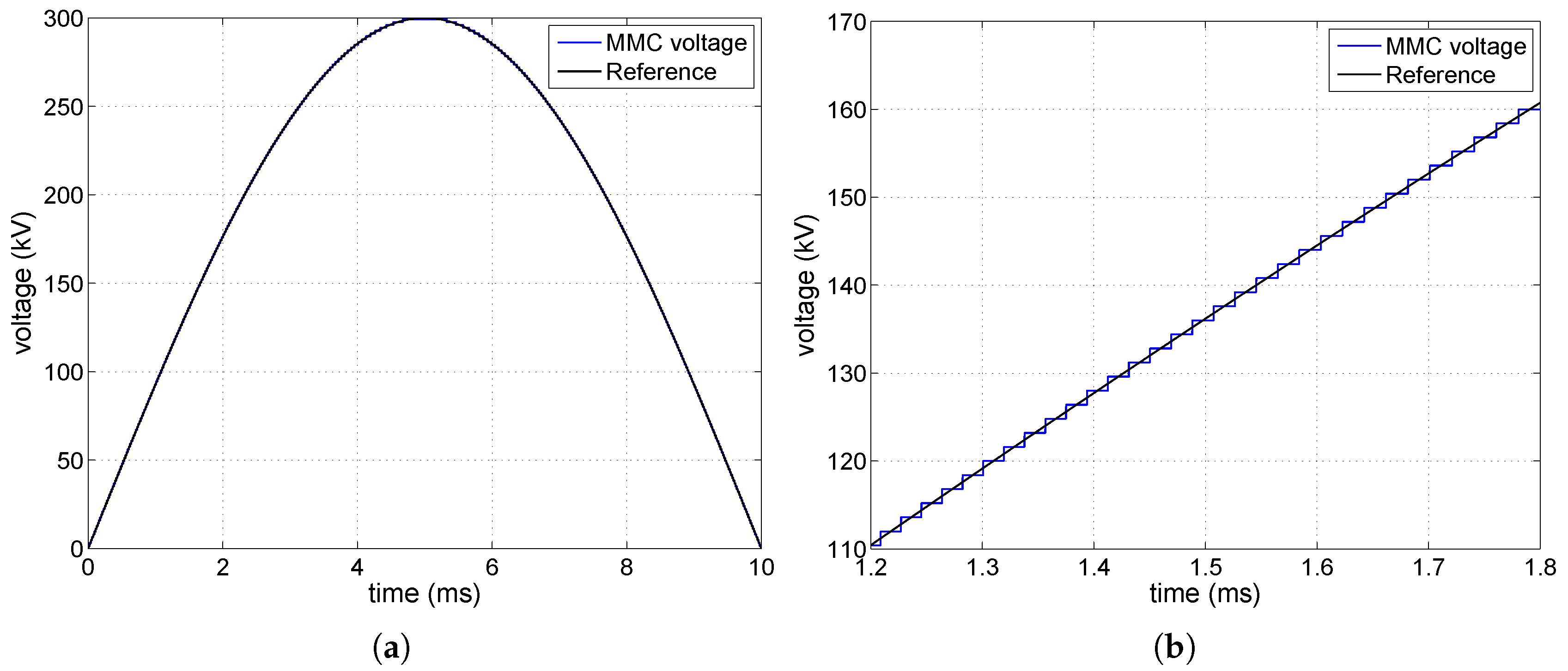
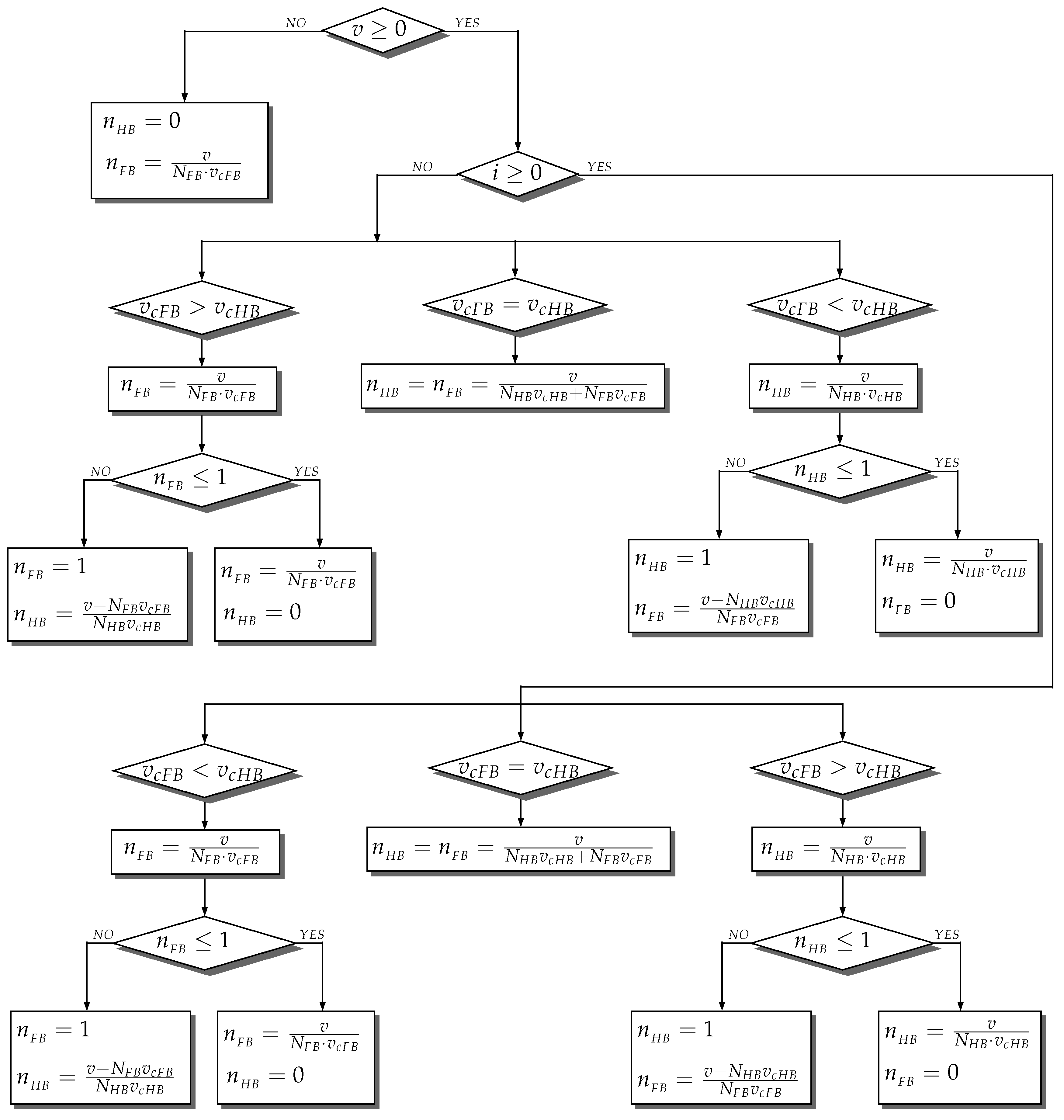
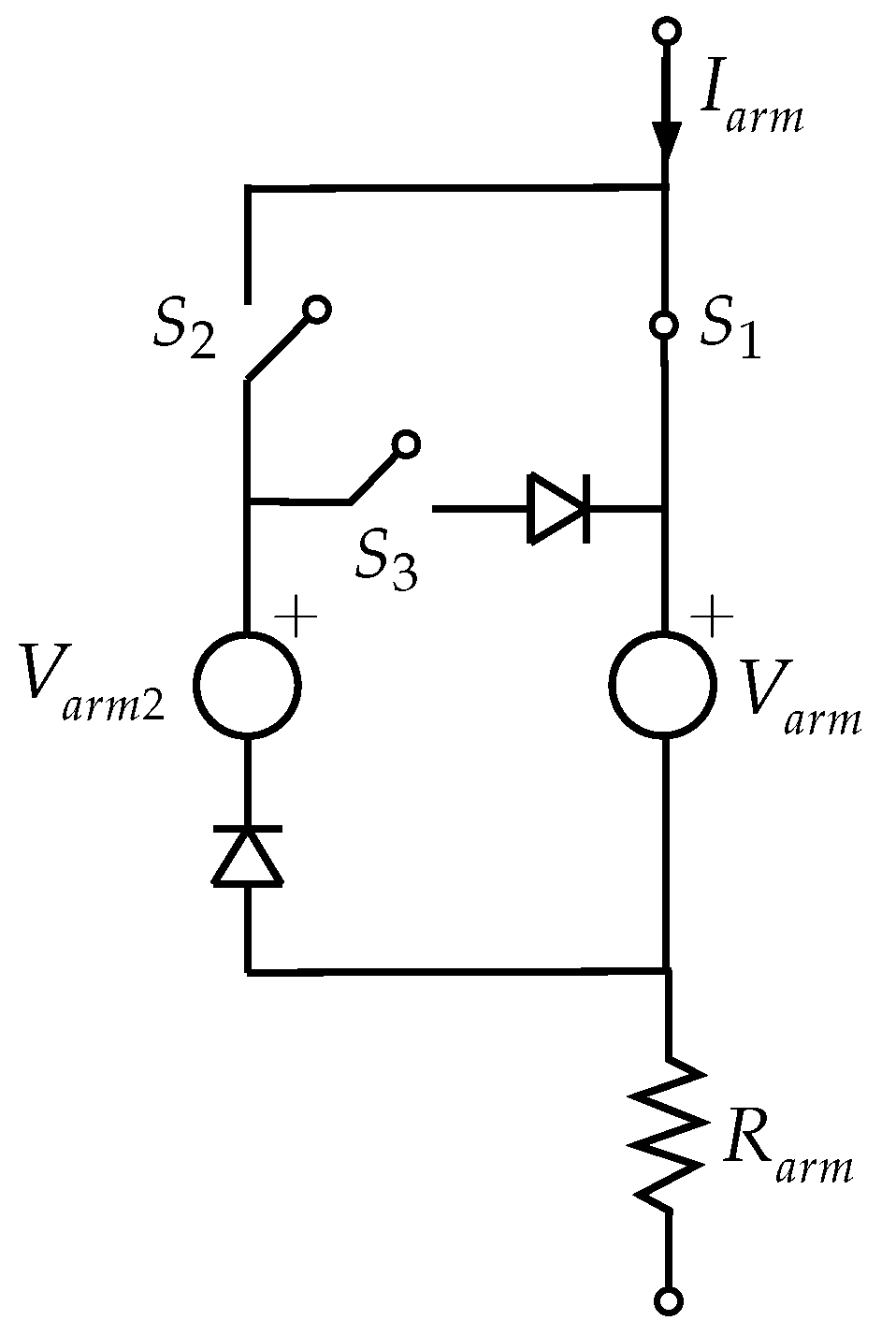

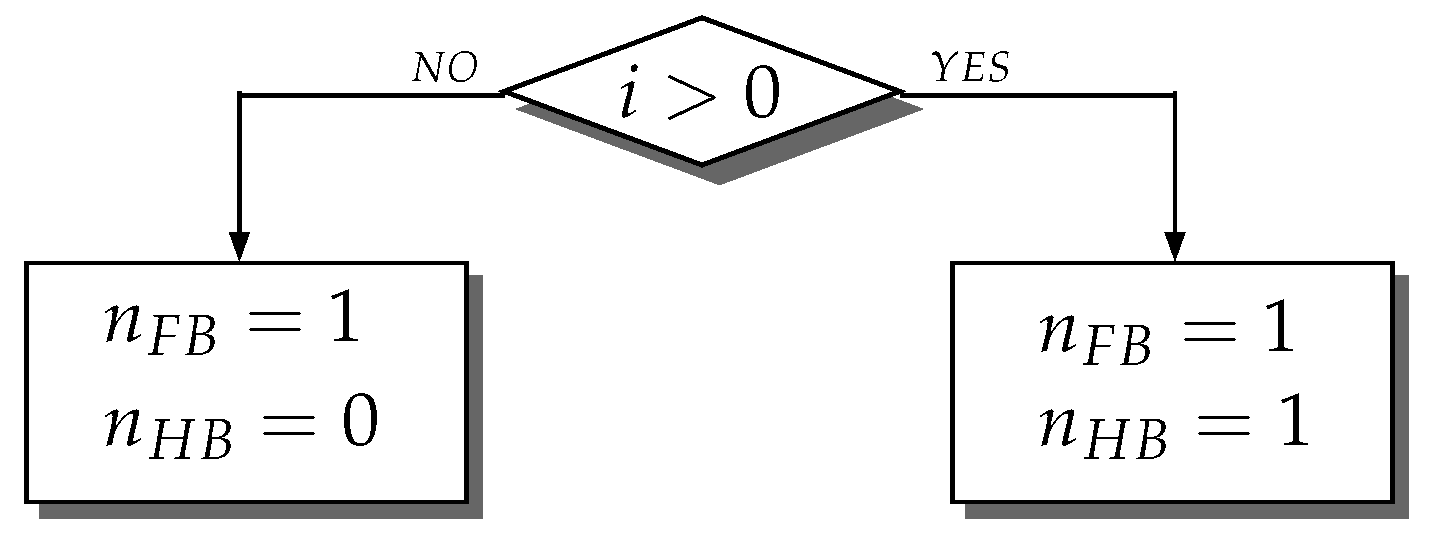


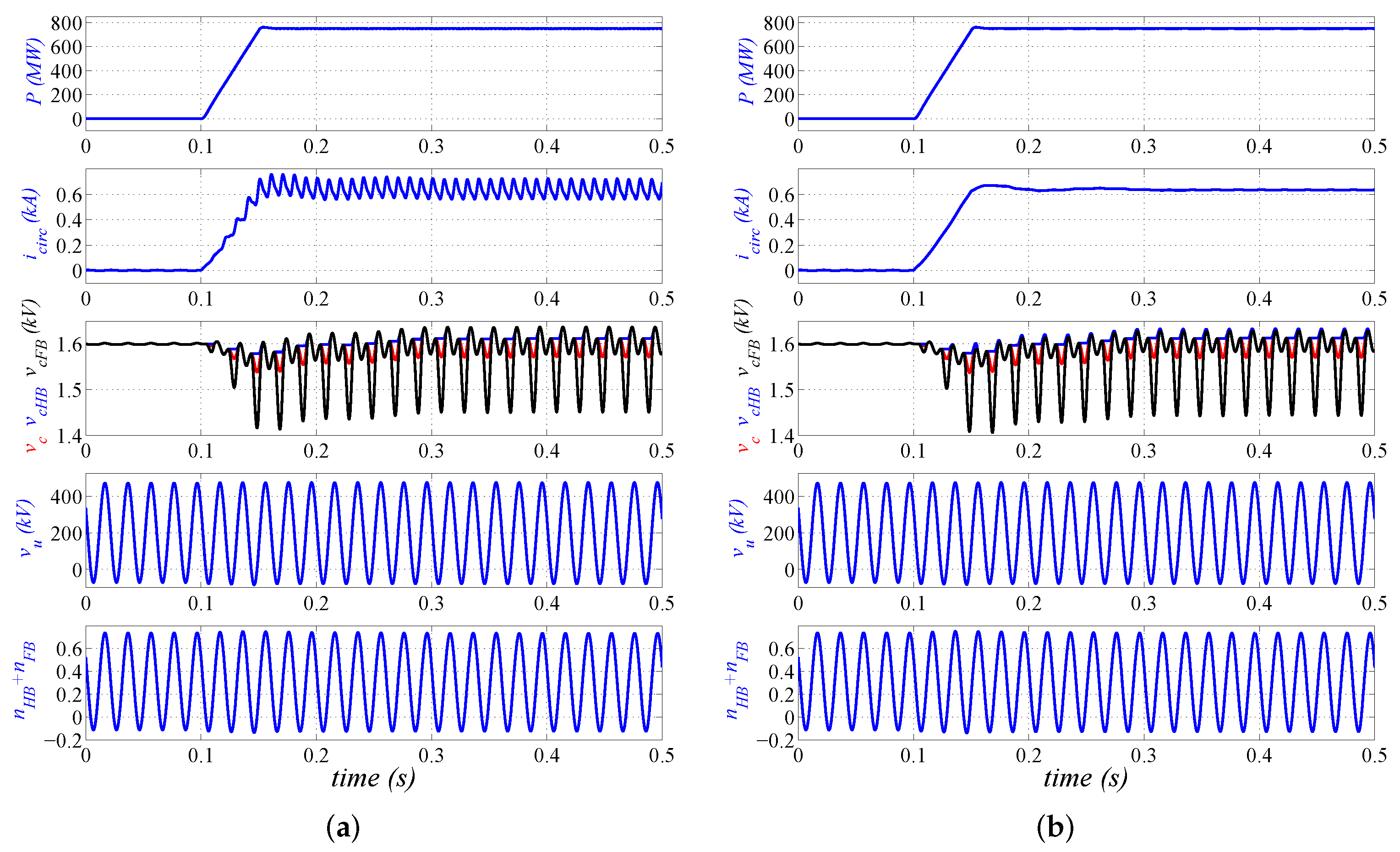
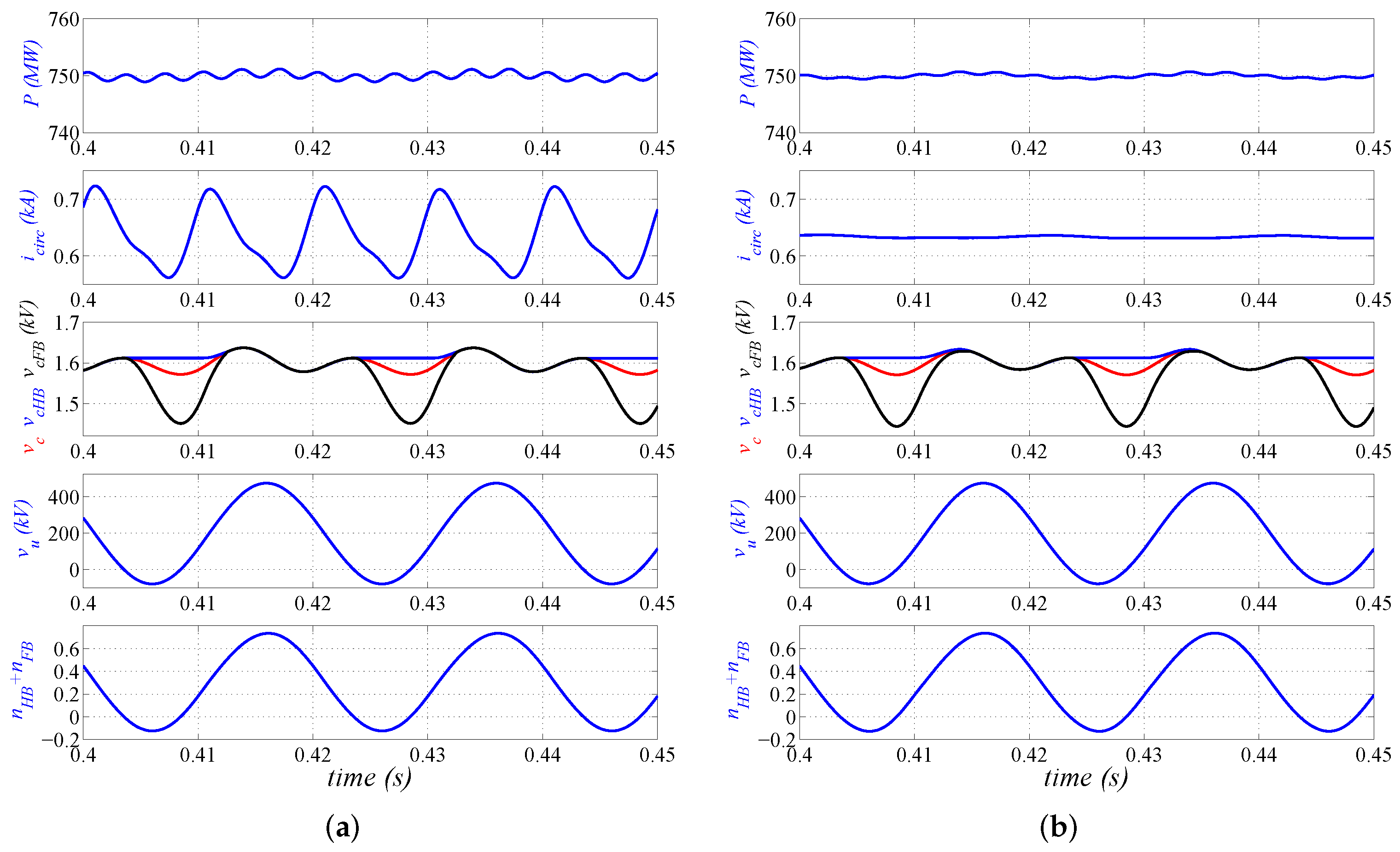
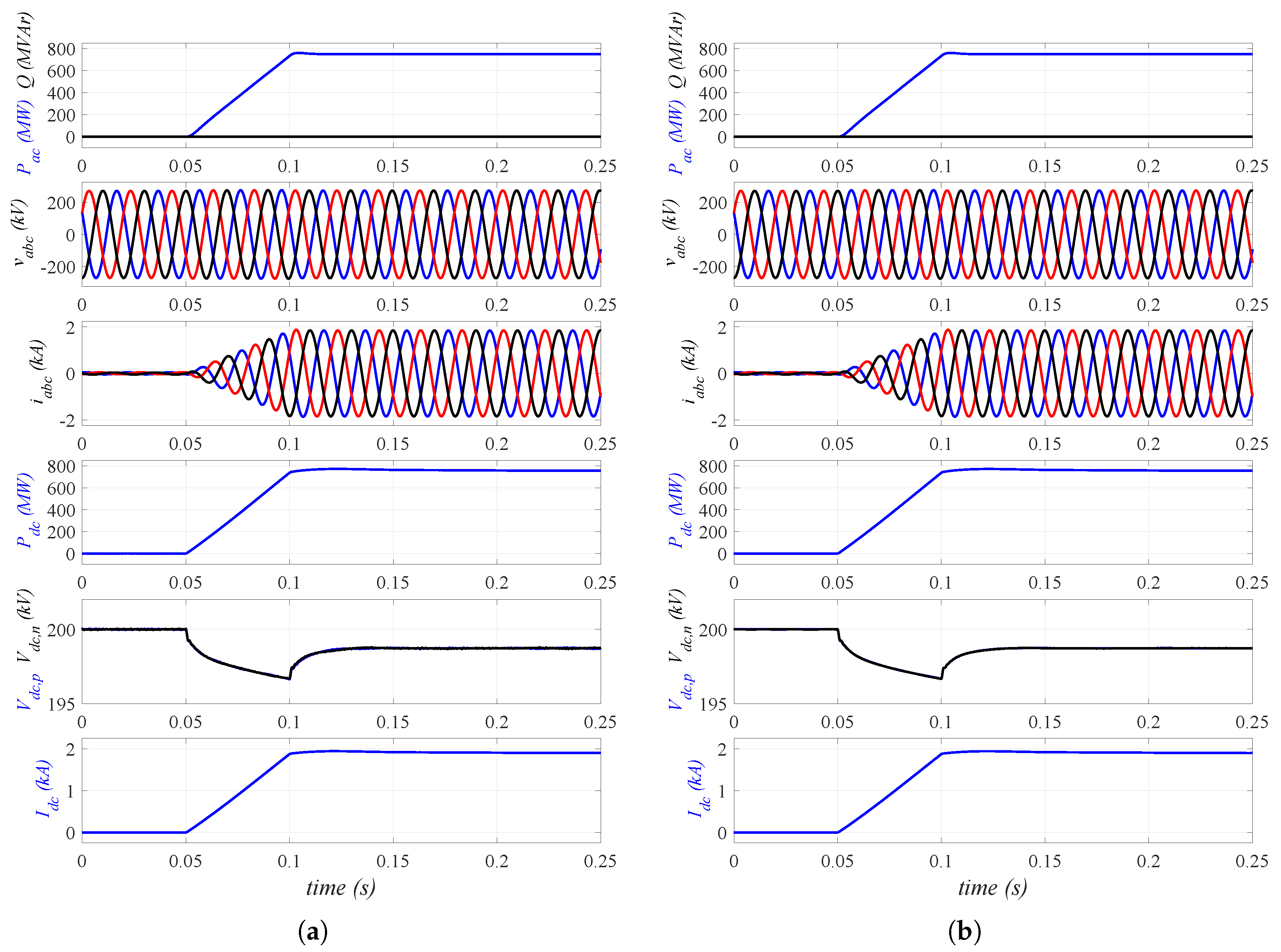


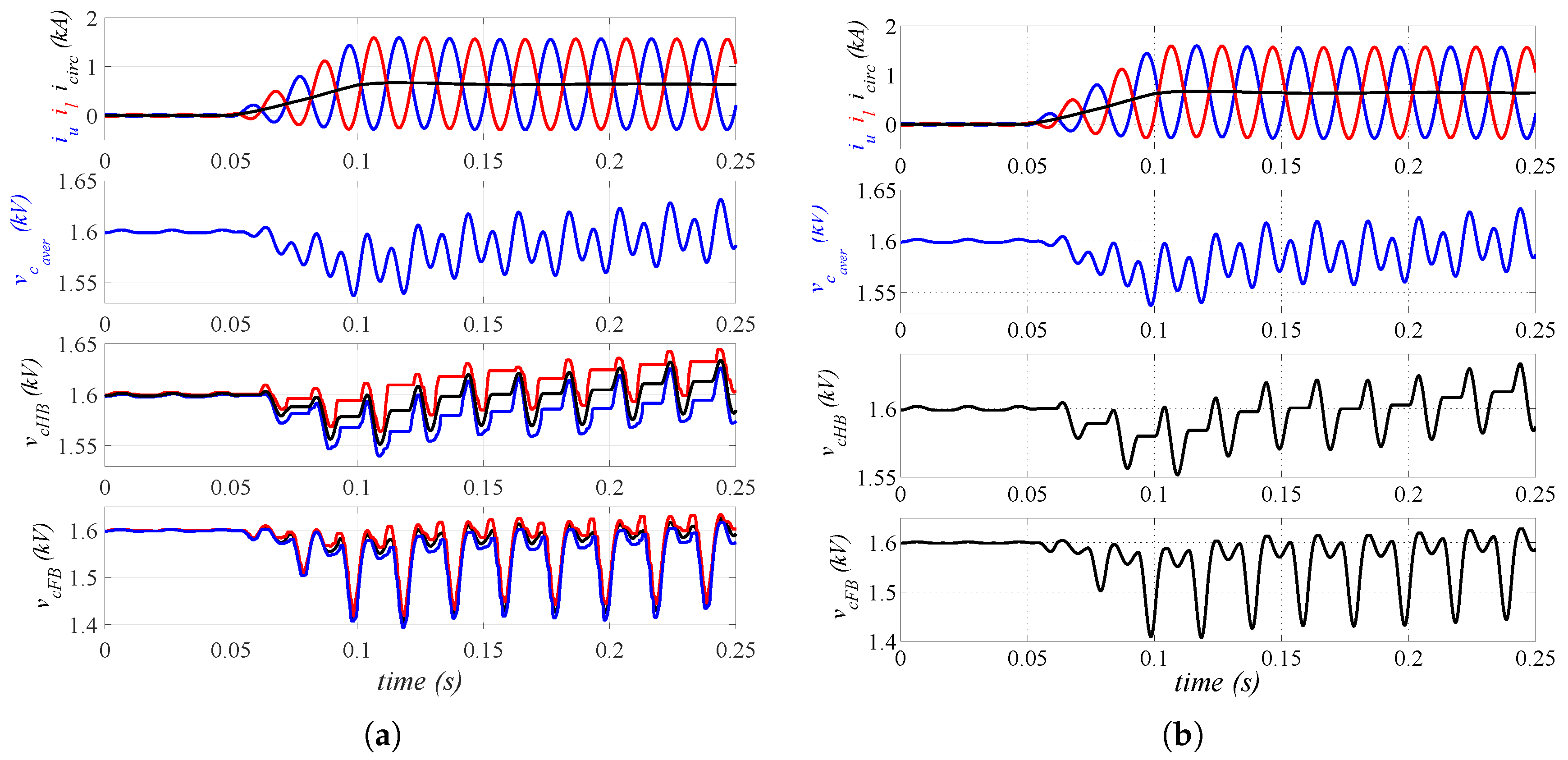



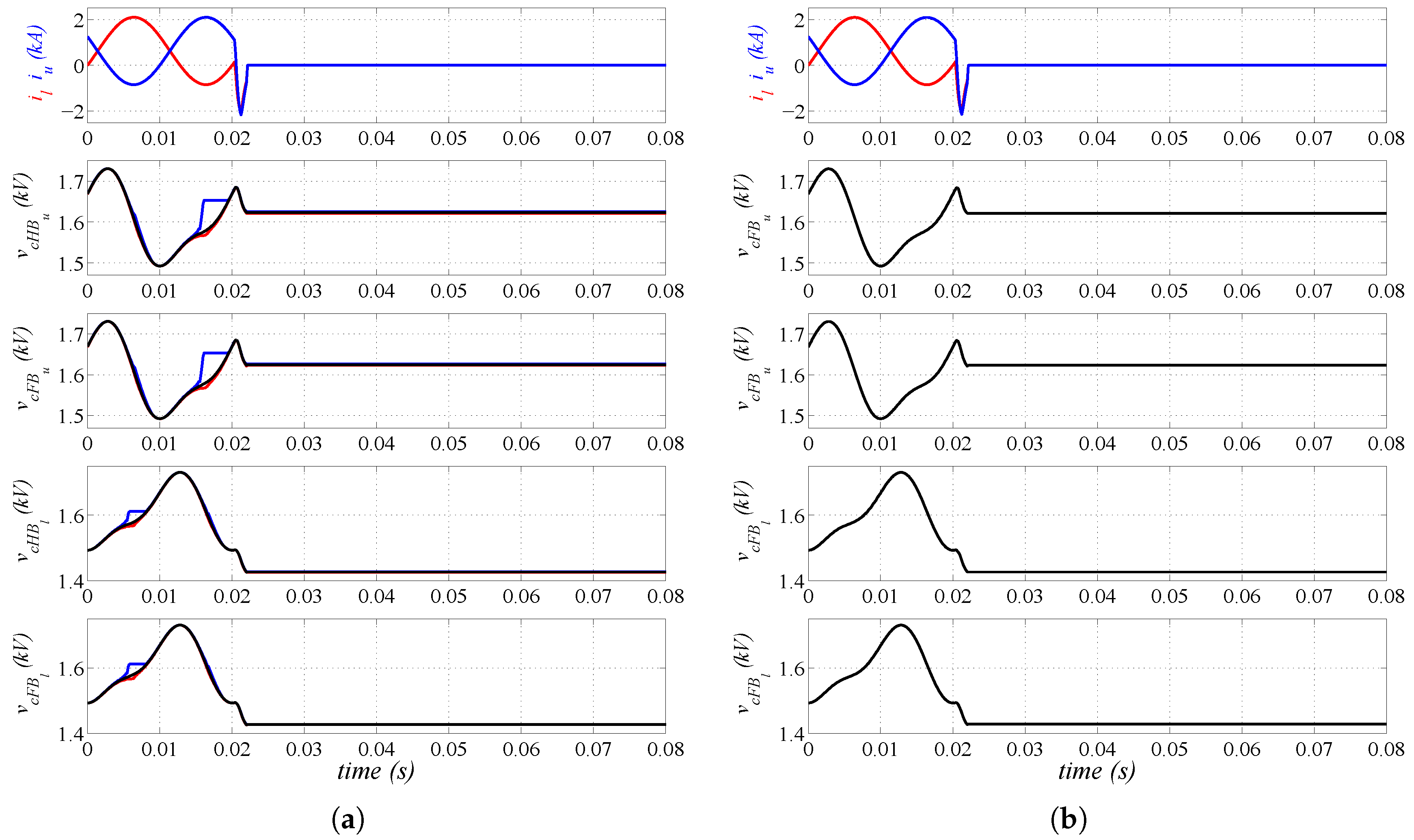



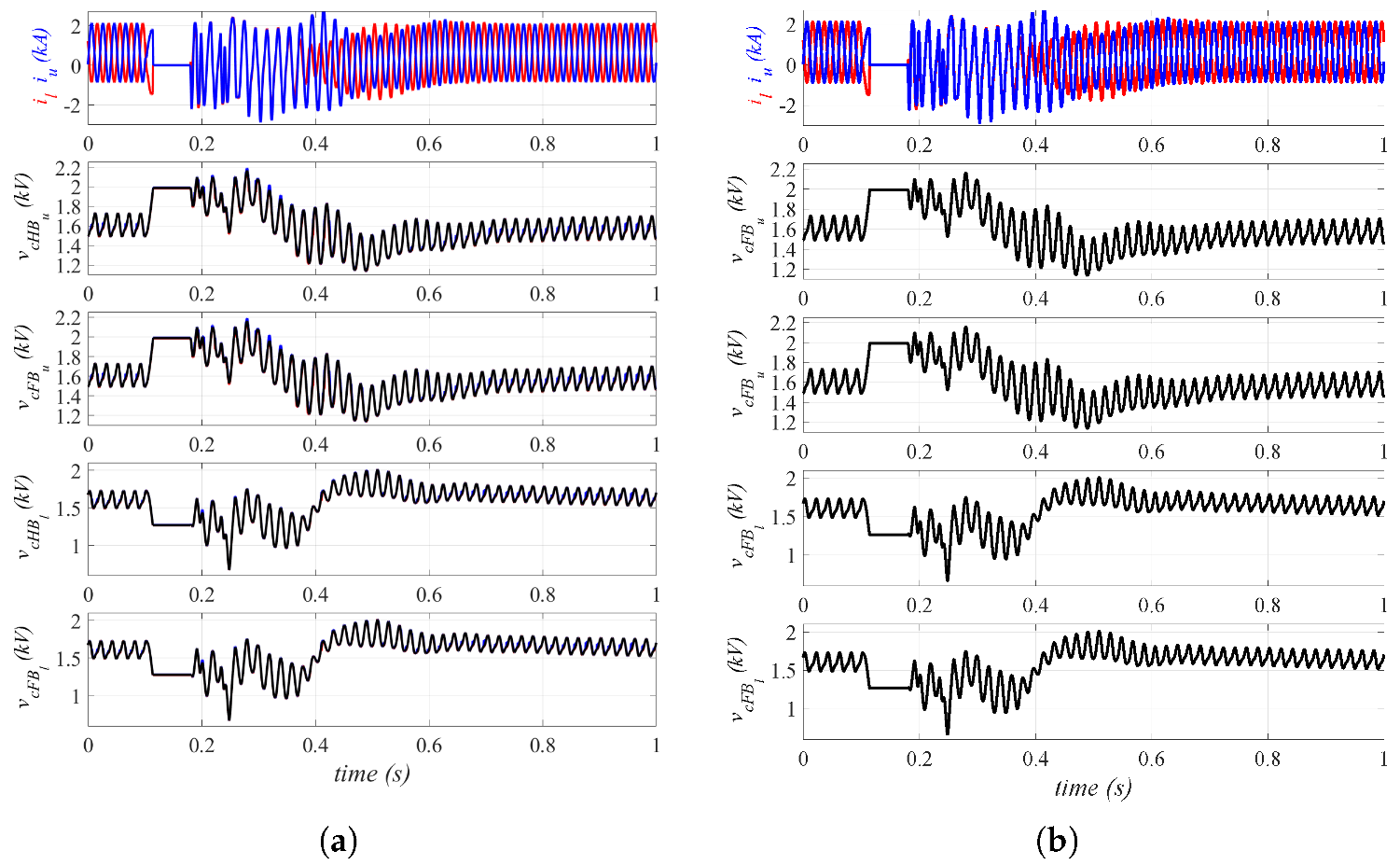

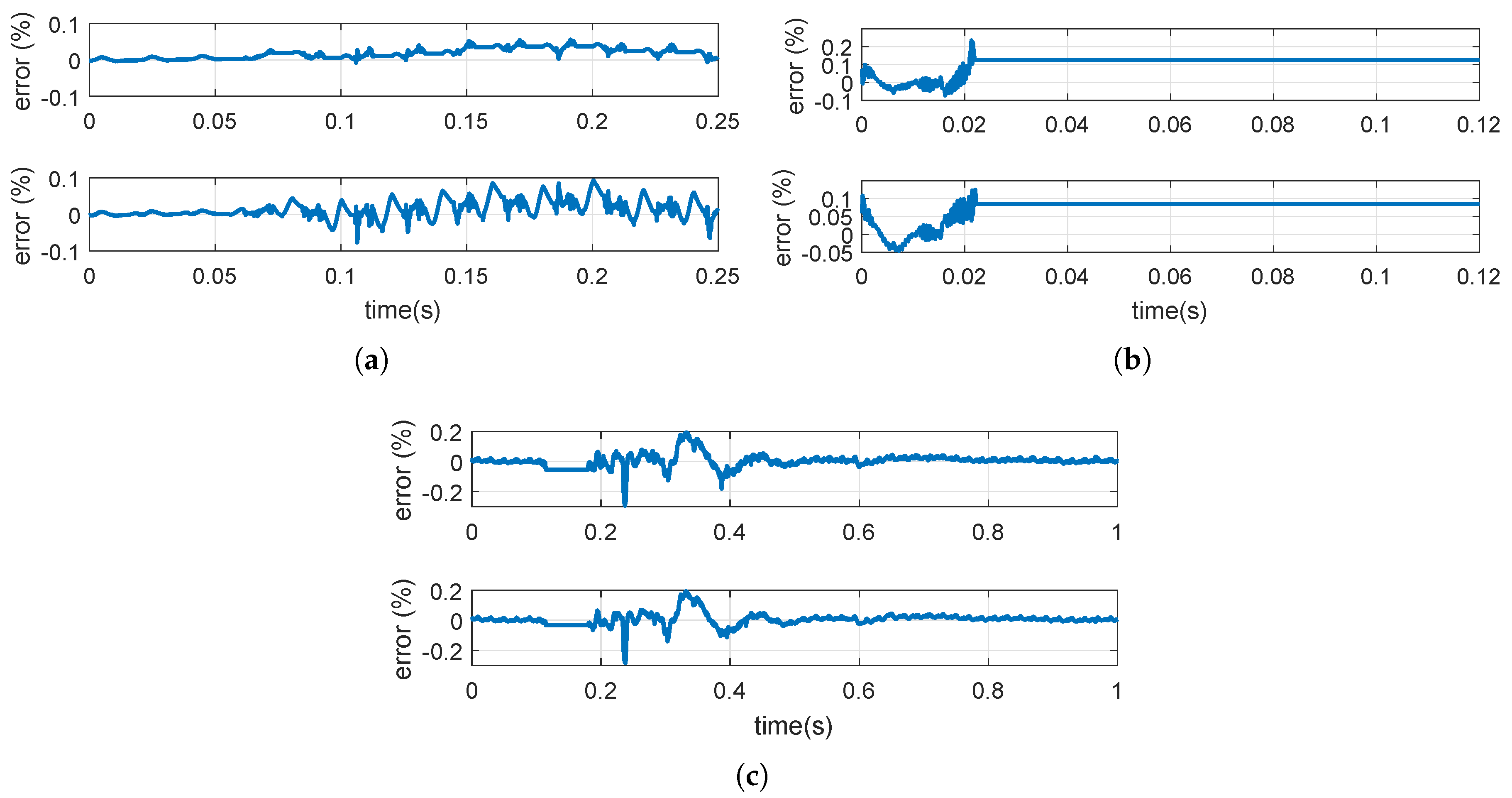
| Bypassed | Inserted | Blocked | ||
|---|---|---|---|---|
| >0 | ||||
| <0 | ||||
| >0 | ||||
| <0 |
| Bypassed | Inserted + | Inserted − | Blocked | ||
|---|---|---|---|---|---|
| >0 | |||||
| <0 | |||||
| >0 | |||||
| <0 |
| Parameter | Value | Parameter | Value | Parameter | Value |
|---|---|---|---|---|---|
| Active power | 1200 MW | 0.5 mΩ | AC grid voltage | 400 kV | |
| Reactive power | 415 MVAr | 1 mΩ | power | 1300 MVA | |
| Levels | 401 | 1.15 V | kV | ||
| Arm inductance | 41.7 mH | 1.15 V | 0.18 pu | ||
| 14.5 mF | 1.6 kV | 0.01 pu |
| Case | Detailed Model | Simplified Model | Ratio |
|---|---|---|---|
| Normal operation | 480 s | 10 s | 48 |
| DC fault | 418 s | 9 s | 46.4 |
| AC fault | 691 s | 12 s | 57.5 |
© 2020 by the authors. Licensee MDPI, Basel, Switzerland. This article is an open access article distributed under the terms and conditions of the Creative Commons Attribution (CC BY) license (http://creativecommons.org/licenses/by/4.0/).
Share and Cite
Vidal-Albalate, R.; Forner, J. Modeling and Enhanced Control of Hybrid Full Bridge–Half Bridge MMCs for HVDC Grid Studies. Energies 2020, 13, 180. https://doi.org/10.3390/en13010180
Vidal-Albalate R, Forner J. Modeling and Enhanced Control of Hybrid Full Bridge–Half Bridge MMCs for HVDC Grid Studies. Energies. 2020; 13(1):180. https://doi.org/10.3390/en13010180
Chicago/Turabian StyleVidal-Albalate, Ricardo, and Jaume Forner. 2020. "Modeling and Enhanced Control of Hybrid Full Bridge–Half Bridge MMCs for HVDC Grid Studies" Energies 13, no. 1: 180. https://doi.org/10.3390/en13010180






